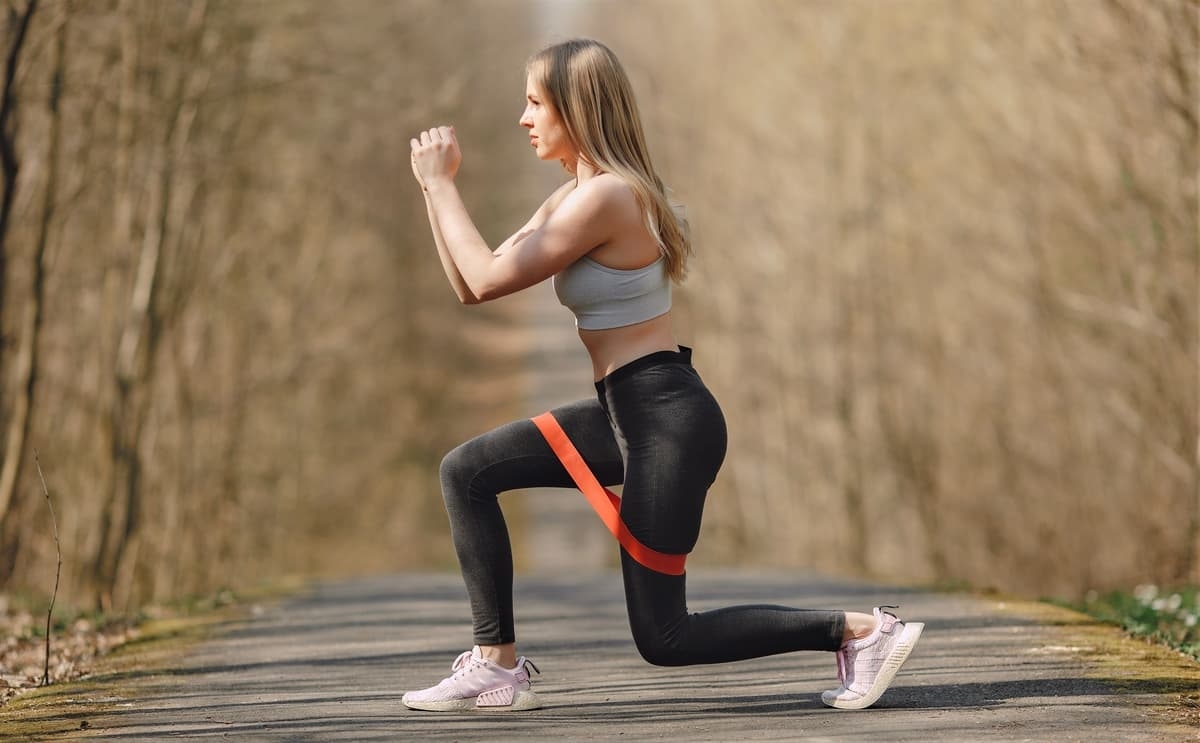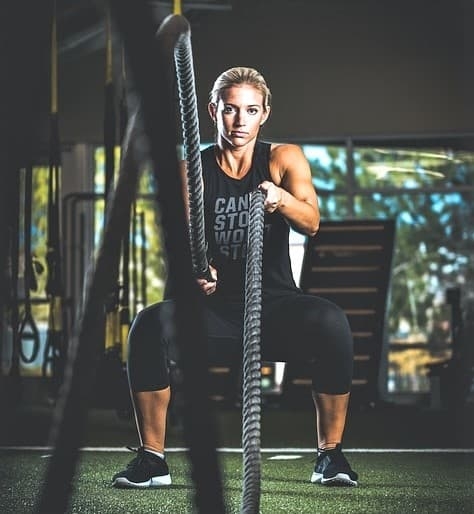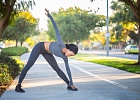
Despite the COVID-19 pandemic and a second Arizona shutdown, plenty of ways remain to keep fit and healthy while safely within the comfort of your home.
The wide array of gyms and recreational venues in Scottsdale help make it a community conscious about health. But you still can stay in shape with them being limited temporarily.
With the help of Scottsdale-based fitness expert Ramsey Bergeron, we’ve compiled a list of the seven best workouts and exercises that can be done with little to no gear.
1) Push-ups

At one point or another, just about everybody has done a push-up.
Sports teams and physical education programs in schools are commonplace for this age-old body weight exercise, and while grueling at times, it is incredibly useful in developing upper-body strength — like in the triceps, shoulders and pectoral muscles.
Bergeron says push-ups are some of the best simple exercises because they utilize several joints, and all you need is the floor.
Types of push-ups
In addition to the standard method, there are a few other ways you can perform a push-up to focus on a particular muscle or change the level of challenge.
Offset Push-Up: Keep one hand against the floor, but elevate the other hand on a step, pile of books or other stable platform so you engage one side more than the other. Once you get tired on one side, rest for a few seconds and repeat on the opposite side.
Decline Push-Up: For an extra challenge with added emphasis on the upper body, try elevating both feet on a higher surface instead. This focuses more weight on the arms and helps make for a more diverse push-up workout.
Knee Push-Up: Some may argue that knee push-ups are to be avoided, but they can actually be quite effective if done correctly. With both knees aligned with your feet, descend all the way and get as close to the floor as you can. These types of push-ups help to place extra emphasis on the abs and chest as well as the arms.
Recommended routine
Bergeron says most trainers who assign a particular number of push-ups or sets base it off an arbitrary decision. Instead, it’s important to remember that when your muscles are fatigued and your form starts to wither, chances are you’re done. Whether your sets consist of eight push-ups or 40, the ideal number is determined by your muscle mood.
2) Planks

When starting off your workout, the plank is one of Bergeron’s go-to recommendations following warm-ups. Once again, all you need is the floor, and this seemingly simple yet immensely effective tool can help to strengthen the gluteal muscles that make up the buttocks.
Form and benefits
When performing a plank, your legs and feet will be in a similar position to that of a push up. This time, however, your elbows and forearms are against the ground instead of your hands to keep you propped up.
Once in a comfortable position, tighten your quads, glutes and core for at least 30 seconds, or as long as you can before your form begins to change. The glutes are most important here, as they can significantly weaken if you find yourself sitting down consistently during the day.
“If you're in that bent position all day, the hip flexor is so tight, so the glute can't fire correctly,” Bergeron says. “If you can’t tighten your butt for 30 seconds while doing a plank, your glutes aren’t firing.”
Like push-ups, planks can be done just about anywhere. Next time you’re put on hold or there is a commercial break, try assuming the position for a few minutes to help balance out the muscle connection between the hip flexor and the glutes.
For added inclusion, Bergeron recommends having a partner watch your backside while you’re doing a plank to encourage and ensure correct form.
#3: Split-leg squat
Even a few sets of standard body weight squats (with feet spread slightly less than shoulder width apart) can satisfy several muscles, including the quads and hamstrings. However, like the offset push-up mentioned earlier, the split-leg squat helps to add emphasis to a particular side.
Bergeron says by having your leg support the entirety of your body in weight challenges, you'll find that people will be able to do a lot more on one leg than the other.
Rest your back leg on a chair, desk or other stable device that is low enough that your knee can still hover over the ground as you descend for the squat. Think of the squatting motion as like performing a lunge, taking a long step forward and raising the heel of the back foot.
Complete one set, switch sides, and repeat.
Recommended routine
Oftentimes, one leg is stronger than the other. You’ll be able to tell by performing split leg squats, as you may notice you can do more sets with the dominant leg than with the weaker one.
Bergeron suggests dialing back the stronger leg’s sets and making them equal with the weaker leg. For example, if you can perform 10 squats on one leg but only eight on the other, try leveling both out at eight each. With consistent training, both legs will strengthen and your set maximum will increase.
4) Side-steps
Equipment needed: Resistance Band
Resistence bands are extremely effective and easy to find at most sporting goods stores. Having one of these can seriously improve gluteal muscles and have them firing properly in no time.
Depending on the tightness of the band, put it around your ankles or knees. From there, go into a semi-squat position and try to do about 20 side-step paces along your living room or back yard. Keep a steady pace to avoid tripping!
Bergeron says side-steps with a band are particularly beneficial for the gluteus medius, located near the outer surface of the pelvis. He considers it one of the best stabilizer and injury-prevention exercises for the hips and knees.
Easier alternative: Sideways leg lifts
If you don’t have a band or feel it is a bit too challenging, try laying on one side and lifting one leg upward, sort of like half a jumping jack.
This will keep your body positioned in one place while still working muscles along the thighs and torso. For an added challenge, try using ankle weights for added resistance.
5) The Wall Angel
For many of us, quarantine has led to a lot of additional sitting. As mentioned earlier, too much sitting can lead to problems with the gluteal muscles firing up. Additionally, all of that extra slouching and hunching can create some serious posture problems.
The wall angel will help to improve posture, reduce neck pain and loosen tightness in the shoulders.
Stand up straight and lean against a wall, but bring your feet out about six inches to level your hips. With your feet in that position, the wall can align with your tailbone all the way along your spine up to your neck.
Now here’s the tricky part: raise both shoulders, extend your elbows out to the sides and raise your hands with palms facing out, similar to swearing an oath in court. If your back begins to pull away from the wall, it means you might have tightness and should continue this routine daily.
Gently raise your hands up and down alongside your body with your back firmly planted against the wall. This motion will provide shoulder pain relief and prevent future tightness.
Bergeron recommends having a partner watch you to help you keep a correct form and stay motivated.
Easier alternative
Instead of standing up against the wall, try lying down on your back with your feet against the floor, so your knees are bent. While this is a lot less strenuous, Bergeron says it still helps to roll your hips forward and reduce tightness.
6) TRX Workouts

Equipment needed: Suspension ropes
Suspension ropes are a common piece of equipment in most gyms. Shaped like an oversize jump rope, they can be anchored to almost any door and are capable of working out almost every part of the body.
Bergeron says Total Resistance Exercises — shortened as TRX — are incredibly beneficial as they can provide various levels of difficulty in addition to variance in muscle groups.
Once your suspension ropes are safely and tightly fastened to a surface, you can lean against them and focus your entire body weight in a trapeze-like motion. From there, the possibilities are plentiful.
Types of workouts
There are dozens of ways you can use suspension ropes to perform TRX exercises, but here are a few of Bergeron’s top suggestions:
Inverted row: Think of this sort of as a reverse pushup. Hold both arms out, grip the ends of the anchored suspension ropes and keep your heels against the ground so only the grip of the ropes is holding you up. From there, pull yourself up and gently release back down. This exercise benefits several muscles including the back, biceps and forearms.
Side planks: While you don’t technically need a TRX device for side planks, it can help to make the exercise more challenging. Strap your feet to the suspension ropes, lean gently at your side with your elbow aligned with the shoulder and drop your hips to the ground, popping back up gently with each descent.
7) Housework

With each household chore, you may be benefitting your body without even knowing it! Bergeron says when it comes to housework, it is all about the mindset.
Try doing lunges while vacuuming, clenching your abs while folding laundry or even tightening your glutes while cooking in the kitchen.
Bergeron says to always think about how you’re moving around the house and how you might be able to improve that movement using some of the exercises we have discussed in this article.
The opportunities are endless, and with a little creativity, a boring day of quarantine can become a complete and balanced workout session.
About the Expert:

Ramsey Bergeron, owner of Bergeron Personal Training in Scottsdale, is a NASM CPT, 8-time Ironman, fitness model, former spokesperson for EAS Sports Nutrition and international adventure travel specialist. Having been a leader in the health and fitness industry for over 12 years, he has been featured in numerous periodicals and over 40 million newspapers across the country. He regularly competes in the Celebrity Nautica Malibu triathlon to raise funds for the Children's Hospital of Los Angeles.
Read more about Ramsey’s programs and experience: www.bergerontraining.com















